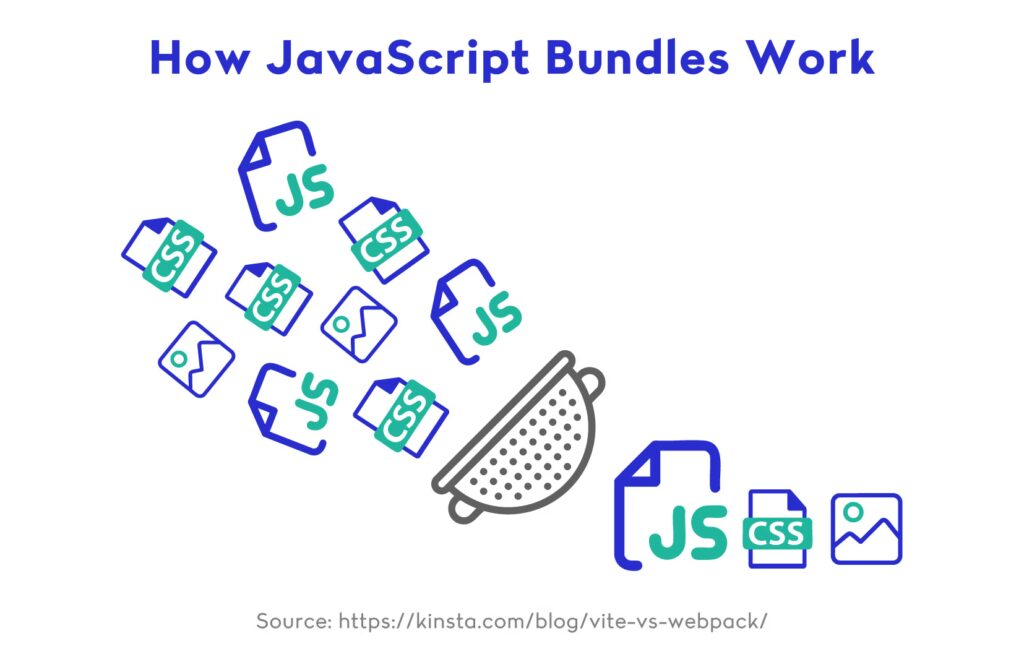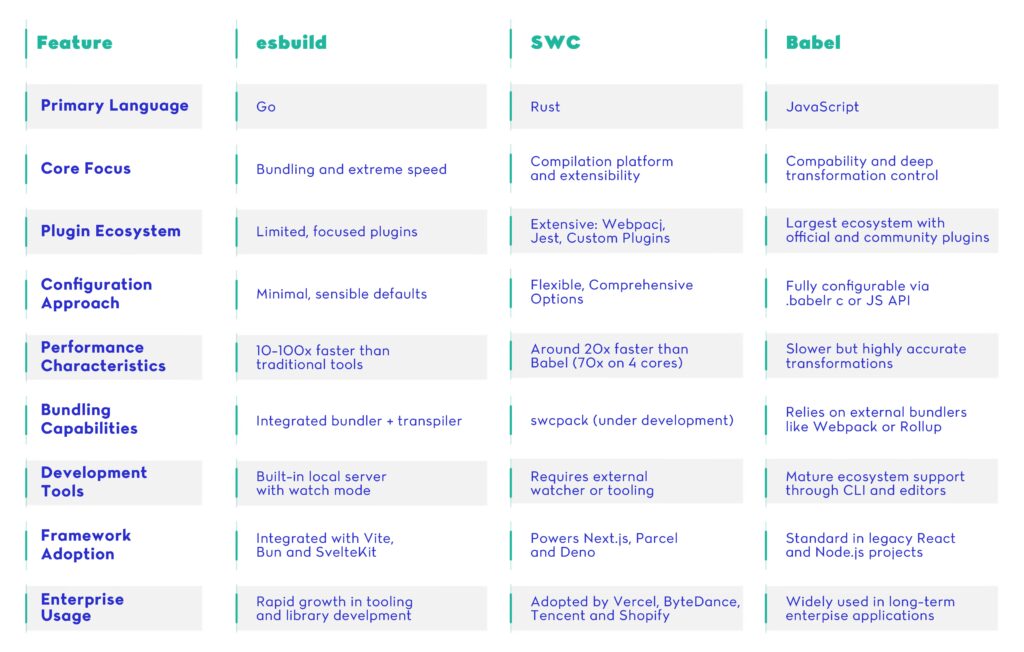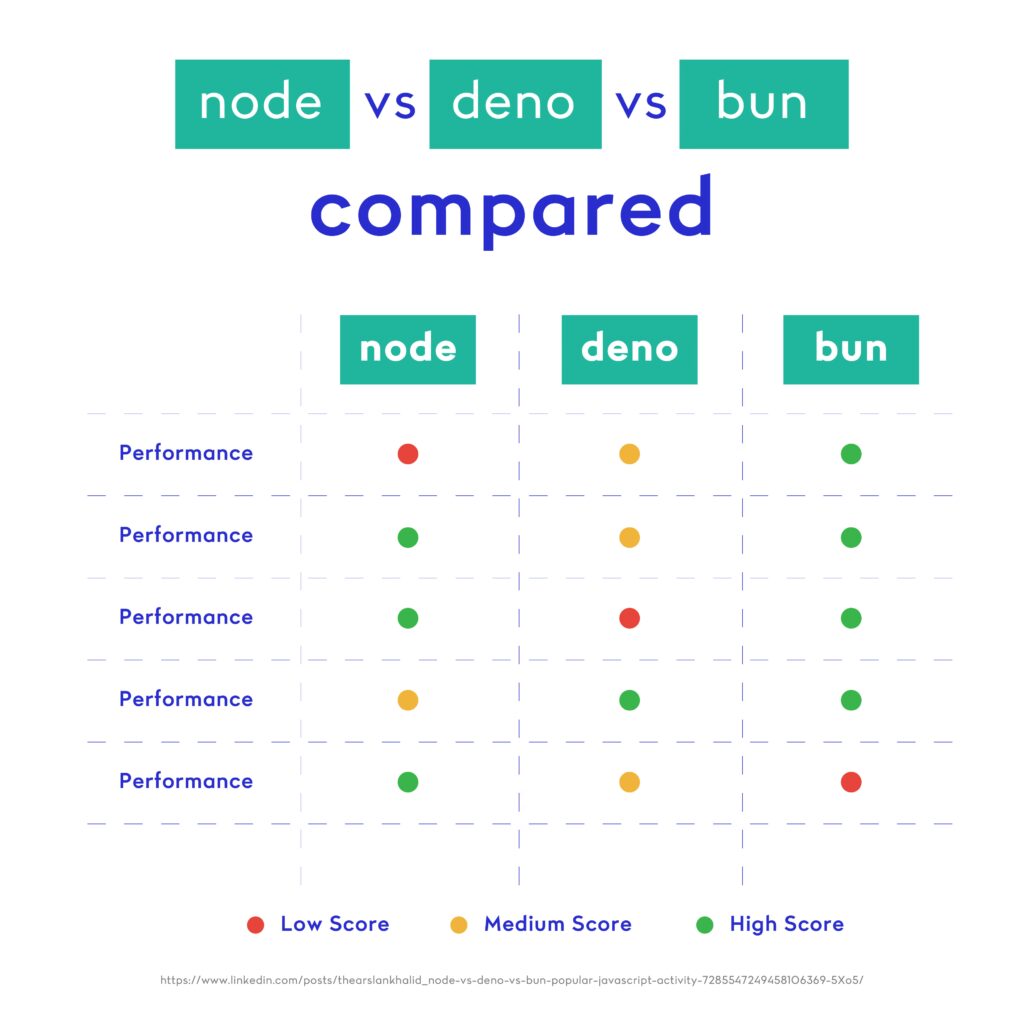In 2025, front-end engineering is evolving faster than ever. Frameworks such as React, Vue, and Svelte keep redefining how teams build, while runtimes like Bun and Deno introduce new ways to execute JavaScript beyond the browser. Amid these changes, developers still rely on a modern toolchain to manage complexity. Bundlers and transpilers remain central to how teams write, optimize, and ship production-ready applications at scale. Selecting the right combination of tools has become one of the most impactful choices for long-term performance, maintainability, and developer experience.
A modern toolchain typically combines three layers: a JavaScript bundler for module aggregation and optimization, a transpiler for syntax transformation and backward compatibility, and a development layer that includes hot module replacement, build servers, and CI/CD integration. Together, these layers determine how quickly developers can iterate, how large builds can scale, and how stable deployment pipelines remain. Choosing poorly can create hidden inefficiencies, as described in Landskill’s own article “Top 7 JavaScript Pitfalls to Avoid When Building Enterprise Apps” — a reminder that foundational technical debt often begins with the wrong build tools.
When evaluating today’s modern toolchain, developers should prioritize measurable criteria. The following points summarize what matters most in 2025:
- Build performance, both cold and incremental
- Developer feedback loop speed, including hot module replacement latency
- Configuration complexity and zero-config readiness
- Ecosystem maturity and plugin availability
- TypeScript and JSX handling quality
- Output optimization such as tree-shaking and code-splitting
- CI/CD compatibility
- Future readiness for WebAssembly, edge runtimes, and modular architectures
Recent studies and developer benchmarks highlight the performance gap between older and newer build systems. A 2024 comparison by Tony Cabaye shows esbuild completing medium-sized production builds in under one second, while Webpack often takes several seconds or even minutes. Kinsta’s 2024 review demonstrates similar trends, with Vite delivering faster development-server startup and improved hot module replacement responsiveness than legacy Webpack. These findings underline why bundlers and transpilers remain core components of every serious JavaScript project: they define not only build performance but also the quality of the overall developer experience.
This article explores the tools and techniques shaping the 2025 ecosystem, explaining how bundlers operate, how transpilers complement them, and which toolchain choices best balance speed, stability, and maintainability. By the end, readers will have a clear framework for selecting or upgrading a modern toolchain suited to their project’s scale and future goals.
What Are Bundlers and Why They Still Matter in 2025
For all the advances in frameworks and runtimes, the JavaScript bundler remains one of the most critical yet least visible tools in the modern toolchain. Every time an application loads efficiently, handles thousands of modules, or integrates TypeScript and CSS seamlessly, a bundler is coordinating that process in the background. Despite speculation that native ES modules or server-side rendering might make bundlers obsolete, production realities continue to prove otherwise.
A JavaScript bundler performs several interconnected steps. It first scans project files and resolves imports to build a dependency graph. Next, it applies transformations—transpiling syntax, injecting polyfills, and processing styles or images. Finally, it optimizes and emits one or more output bundles. This workflow guarantees consistent, predictable builds across environments. Without it, developers face performance inconsistencies, duplicate dependencies, and brittle deployment pipelines.

As front-end applications scale, the JavaScript bundler has evolved from a background utility to a measurable performance component. Enterprise codebases may contain thousands of dependencies contributed by multiple teams. The bundler enforces order, deduplication, and optimization, ensuring that production code is compact, consistent, and secure. In 2025, bundlers are monitored alongside runtime metrics—cold build speed, incremental rebuild latency, and plugin overhead are all treated as KPIs for developer experience.
The evolution of the JavaScript bundler
The early days of Browserify and Grunt introduced basic module packaging. Webpack later unified the ecosystem with loaders, plugins, and code-splitting, creating a flexible if sometimes cumbersome foundation. In 2024 and beyond, the market shifted toward faster, developer-focused alternatives. Tools such as Vite, Rollup, Parcel, and esbuild have redefined expectations by emphasizing minimal configuration and near-instant feedback loops.
A developer deep dive at dev.to compares these bundlers across real projects, highlighting how Vite and esbuild have overtaken Webpack in developer satisfaction while Rollup maintains its role for library authors. The article notes that teams adopting Vite for large React or Vue projects report faster development cycles and more predictable deployments. These insights mirror what engineering managers now see in daily production pipelines: the JavaScript bundler directly affects time-to-market.
Comparing modern bundlers
Each modern JavaScript bundler now occupies a distinct niche:
- Webpack remains the enterprise standard for complex configuration, plugin control, or module federation. It is mature but slower, with higher maintenance overhead.
- Rollup focuses on library and design-system builds. Its precise tree-shaking generates compact bundles ideal for shared components.
- Vite represents the current generation of fast, developer-centric bundlers. It uses esbuild under the hood for development and Rollup for production, providing instant reloads and minimal rebuild delay.
- Parcel targets simplicity through zero-configuration defaults, automatically detecting project types and dependencies.
- esbuild stands apart for raw speed. Written in Go and fully parallelized, it doubles as both a JavaScript bundler and a transpiler, supporting TypeScript and JSX out of the box.
To illustrate how adoption reflects these differences, the chart below compares npm download trends for the five leading JavaScript bundlers—esbuild, Parcel, Rollup, Vite, and Webpack—over the past five years.

The data shows a sharp upward trajectory for Vite beginning in early 2024, briefly surpassing all other bundlers in download volume. esbuild follows closely, reflecting its widespread adoption as both a standalone JavaScript bundler and the engine powering faster toolchains. Webpack still maintains a significant, stable base thanks to its enterprise integrations, while Rollup and Parcel continue to serve smaller but loyal user communities.
This five-year comparison also highlights how quickly modern developer teams respond to performance-driven tooling. The surge in Vite and esbuild usage corresponds directly to measurable gains in build performance and developer feedback loops reported in 2024 benchmarks. It confirms that the JavaScript bundler is no longer chosen solely for ecosystem size but for its measurable impact on productivity and scalability.
According to the 2025 Guide to JS Build Tools published by ThisDot Labs, most new projects now adopt Vite or esbuild as defaults, while Webpack remains entrenched in large, long-term enterprise environments. This real-world data supports the broader trend visible in the graph: the ecosystem is consolidating around faster, modular, and developer-friendly JavaScript bundlers that align with modern toolchain priorities.
Why bundlers remain indispensable
Despite the rise of native ES modules, every serious project still depends on a JavaScript bundler for production. Tasks such as tree-shaking, code-splitting, minification, and asset compression remain critical for performance budgets. Applications that mix TypeScript, JSX, CSS-in-JS, and WebAssembly cannot function without preprocessing. Bundlers manage those pipelines while ensuring reproducible outputs for continuous delivery.
In enterprises that depend on automated pipelines, the JavaScript bundler is the bridge between developer environments and deployment systems. Build artifacts must remain deterministic and traceable—an expectation documented in Landskill’s DevOps article “CI/CD Pipeline Automation: A Complete Beginner-to-Expert Guide for Modern DevOps”. Without deterministic bundling, continuous integration becomes fragile, and debugging production mismatches can cost weeks of effort.

Developer feedback loops are another area where the JavaScript bundler proves its worth. During active development, tools like Vite and esbuild can rebuild or reload code in under 100 milliseconds. This responsiveness keeps developers in flow and reduces cognitive friction. By contrast, older Webpack pipelines may take several seconds per rebuild, creating a noticeable interruption. For distributed teams operating in global CI/CD environments, this performance difference scales directly into measurable productivity gains.
Limitations and trade-offs
The flexibility that makes bundlers powerful can also make them complex. Webpack’s detailed configuration files remain intimidating for newcomers. Even with modern bundlers, plugin compatibility and version alignment can be challenging. The 2025 overview from ThisDot Labs emphasizes that despite these obstacles, new projects consistently favor speed-first ecosystems because the benefits to developer experience outweigh the learning curve. As teams modernize, many maintain transitional setups—retaining Webpack for legacy modules while migrating new services to Vite or Rollup.
Ecosystem fragmentation remains an ongoing issue. Each JavaScript bundler evolves independently, so plugin ecosystems and documentation often diverge. However, initiatives like Rspack and Turbopack seek to merge Webpack compatibility with Rust-level performance, signaling a gradual convergence rather than permanent fragmentation. The trend points toward a future where bundlers and transpilers function as unified build engines instead of separate processes.
The role of the bundler in the modern toolchain
In 2025, the JavaScript bundler is expanding beyond static asset management. Frameworks like Next.js and SvelteKit embed bundlers into server-side rendering and edge-deployment pipelines. Micro-frontend systems depend on bundlers for module federation, allowing teams to share code securely across applications. The continued growth of edge computing pushes developers toward smaller, pre-optimized bundles that execute instantly near users.
Far from being replaced, the JavaScript bundler has become more strategic. It anchors performance, maintainability, and team productivity across the software lifecycle. As companies scale distributed architectures, a well-chosen bundler ensures faster iteration, stable builds, and measurable cost savings in compute and developer hours. In every sense, it remains the cornerstone of the modern toolchain.
What Are Transpilers: The Compile-Time Tools You Need
If the JavaScript bundler is the backbone of the modern toolchain, the JavaScript transpiler is its translator. Every modern project relies on a transpiler to convert one version or flavor of JavaScript into another that browsers or runtimes can execute consistently. In 2025, as language features advance faster than browser adoption, the JavaScript transpiler remains essential for bridging innovation and compatibility.
A JavaScript transpiler takes modern syntax—typically TypeScript, JSX, or upcoming ECMAScript proposals—and compiles it into plain JavaScript that runs everywhere. This process lets developers use the newest language features while maintaining stable runtime behavior. Transpilers also handle polyfills, source maps, and transformation pipelines that keep debugging accurate and consistent across environments.
How transpilers fit into the modern toolchain
In a typical build pipeline, the JavaScript transpiler runs before or alongside the bundler. It converts source files into a consistent syntax layer that the bundler can process and optimize. Tools such as Vite or esbuild integrate transpilation directly into their core, removing the need for a separate Babel step. This integration reduces configuration complexity, accelerates builds, and helps maintain predictable outputs across continuous-integration environments.
A technical article from the LogRocket blog explains how SWC’s architecture achieves faster compilation through Rust’s parallelization model. Official benchmarks published by the SWC project confirm that SWC outperforms Babel in both cold and incremental builds, validating the shift toward newer high-performance compilers. These improvements have made integrated build systems far more appealing than traditional multi-step toolchains.
The dominant JavaScript transpilers in 2025
The ecosystem has consolidated around a few core engines:
- Babel – the long-established JavaScript transpiler known for extensive plugin support and ECMAScript proposal coverage.
- SWC – a Rust-based compiler that maintains Babel compatibility while delivering orders-of-magnitude faster compile times.
- esbuild – written in Go, functioning as both a JavaScript bundler and a JavaScript transpiler, and providing instant transformation inside frameworks like Vite and Bun.
Performance comparisons on BetterStack show that both SWC and esbuild consistently outperform Babel in build speed while maintaining output stability. SWC’s architecture excels in TypeScript workloads, and esbuild dominates in integrated environments where bundling and transpilation occur simultaneously.
The distinctions between modern transpilers are best illustrated by their core design priorities. While esbuild and SWC emphasize speed and integration, Babel continues to dominate in plugin depth and backward compatibility. The comparison below summarizes how each JavaScript transpiler aligns with current toolchain demands.

TypeScript as a driving force
TypeScript continues to anchor the modern toolchain. Its compiler (tsc) remains the authority for type checking, but many teams now rely on SWC or esbuild for code transformation. This hybrid strategy—tsc for types, a high-speed JavaScript transpiler for output—balances safety with performance.
State of JS 2024 reported that more than 60 percent of respondents use an alternative transpiler to accelerate TypeScript projects. The 2025 Vite documentation similarly recommends SWC or esbuild as default engines for production-grade applications, citing their performance and low-configuration setup.
Performance and developer experience
Performance numbers tell only part of the story. Developer experience defines how valuable a JavaScript transpiler truly is. Faster incremental builds, clear diagnostics, and accurate source maps translate directly into higher team velocity. When a transpile step drops from ten seconds to one, the cumulative time savings across hundreds of builds per day are substantial.
The 2025 guide from ThisDot Labs emphasizes that integrated toolchains—where the transpiler is embedded within the bundler—reduce friction and redundancy. Teams migrating from Babel to SWC or esbuild consistently report leaner CI/CD pipelines, faster deployments, and simpler maintenance.
Limitations and trade-offs
Modern transpilers still present trade-offs. SWC’s plugin ecosystem, while improving rapidly, occasionally trails Babel in advanced transformations. esbuild’s simplicity limits fine-grained customization. Babel, though slower, remains indispensable for projects that rely on experimental syntax or require highly specialized macros.
Community discussions such as the 2025 r/webdev thread on Reddit underline these realities: performance gains are impressive, but teams must validate that their pipeline’s plugins and transformations behave identically before migrating.
The continuing importance of the transpiler
Every major JavaScript project still depends on a transpiler, even when frameworks hide it under the surface. Whether compiling TypeScript, converting JSX, or implementing future ECMAScript syntax, the JavaScript transpiler ensures cross-platform reliability and consistent developer experience.
As toolchains converge, the distinction between bundler and transpiler is narrowing—but each still serves a unique purpose. The bundler packages and optimizes; the transpiler translates and aligns syntax across targets. Together, they form the heart of the modern toolchain, enabling faster iteration, safer releases, and future-proof development practices for 2025 and beyond.
The Modern Toolchain in 2025: Bundler + Transpiler + Runtime
In 2025, development teams no longer think of the JavaScript bundler and the transpiler as separate components. Instead, they operate as parts of an integrated build pipeline that includes development servers, hot module replacement, and runtime environments. This evolution reflects the industry’s broader move toward unified developer experiences—where configuration, compilation, and deployment function as a continuous loop rather than isolated processes.
How integration reshaped the toolchain
Early pipelines relied on multiple discrete tools: a transpiler such as Babel for syntax conversion, a JavaScript bundler such as Webpack for packaging, and a runtime or server framework for delivery. Each layer required its own configuration and maintenance. By 2024, the rising cost of complexity and performance bottlenecks drove the rise of integrated systems like Vite, Bun, and Turbopack, which merge these responsibilities into a single, coordinated toolchain.
An overview by JavaScript in Plain English highlights how this convergence is redefining development speed and maintainability. Integrated tools deliver shorter feedback loops, simplified setup, and better performance in both local and cloud environments. The same report notes that these unified systems can reduce build and reload times by up to 90 percent in active development workflows.
The runtime connection
The runtime now plays a central role in how the JavaScript bundler operates within the modern toolchain. Runtimes such as Node, Deno, and Bun are no longer just execution layers—they actively influence how bundling and transpilation occur. Each runtime introduces distinct priorities in performance, module systems, and ecosystem maturity.

According to developer comparisons across multiple ecosystems, Bun achieves higher raw performance and tighter integration with modern build tools. Deno offers enhanced security and native TypeScript support, while Node maintains the broadest ecosystem and compatibility. For teams choosing a JavaScript bundler, understanding these runtime characteristics is essential because they determine how efficiently bundling and transpiling can occur in production environments.
Modern runtimes also blur traditional boundaries. Bun, for example, includes an integrated JavaScript bundler and transpiler, allowing developers to write and execute TypeScript without external tools. This reduces cold-start latency and simplifies CI/CD workflows. Deno provides similar capabilities through native ES module support and direct TypeScript execution.
However, this deeper integration comes with trade-offs. When the runtime, bundler, and transpiler are all part of a single system, updates or regressions in one layer can ripple across the entire pipeline. Enterprises benefit from the speed and simplicity of these unified architectures but must also weigh long-term maintainability and compatibility.
Real-world integration patterns
By mid-2025, three dominant integration patterns have emerged:
- Hybrid integration – Combines a JavaScript bundler such as Vite or Rollup with SWC for transpilation. This approach balances modular control with performance and supports incremental migration from legacy tools.
- Runtime-centric integration – Found in Bun and Deno, where bundling and transpilation occur directly within the runtime, offering minimal setup and optimal startup performance.
- Cloud-native build services – Platforms such as Vercel and Netlify provide hosted pipelines powered by esbuild or SWC. Teams benefit from fast builds without managing infrastructure, though customization is limited.
Each pattern serves a different need. Large applications with micro-frontend architectures often prefer Vite for its flexibility, while startups or serverless platforms adopt Bun for its simplicity and speed.
Performance and developer experience
The fusion of the JavaScript bundler and transpiler has redefined the meaning of productivity in modern development. Toolchains now deliver instant hot reloads, faster incremental builds, and deterministic output. Benchmarks released by Turbopack in 2024 show up to 95 percent faster rebuilds than legacy Webpack configurations.
A 2025 developer survey summarized on dev.to reports that over 70 percent of teams now prioritize developer feedback speed over plugin ecosystem size or legacy compatibility. This trend underscores a fundamental shift: the success of a JavaScript bundler is measured as much by the experience it enables as by its raw output performance.
Trade-offs of integration
Despite clear benefits, unified toolchains introduce trade-offs. When the JavaScript bundler and transpiler share a single architecture, a regression in one layer can disrupt the entire build. Migration between integrated systems can also be difficult, as plugins or configurations may not translate cleanly. For long-term or regulated projects, maintaining loosely coupled modules remains the safer choice even if it adds initial setup overhead.
The future of the modern toolchain
Looking ahead, the next generation of build systems will likely emphasize automation and context awareness. Toolchains will adapt dynamically to hardware, runtime environments, and deployment targets. Research from Cornell University on adaptive build pipelines explores self-optimizing systems that tune performance based on codebase complexity and infrastructure conditions. Whatever direction the ecosystem takes, the JavaScript bundler will continue to serve as the orchestrator—coordinating syntax translation, optimization, and delivery across the entire development lifecycle.
Performance Metrics and Trade-Offs in Modern Toolchains
Choosing the right JavaScript bundler in 2025 is no longer about configuration flexibility or plugin count; it’s about measurable performance. Development teams now evaluate their entire build system using quantifiable metrics that directly influence developer velocity, deployment stability, and infrastructure cost. The modern toolchain is expected not only to compile fast but to scale efficiently across teams and environments.
Core metrics that define performance
Across the ecosystem, three key categories define the performance of a JavaScript bundler:
- Cold build time – the total duration from a clean build to a production-ready output. This metric affects CI/CD pipelines, staging environments, and initial developer startup times.
- Incremental rebuild latency – how long it takes the toolchain to rebuild after a single file change, directly shaping developer productivity.
- Bundle efficiency – the final output size and how effectively unused code is removed through tree-shaking, compression, and module deduplication.
According to 2024 research compiled by Tony Cabaye, esbuild maintains sub-second rebuild times even for large TypeScript projects, while Vite and SWC-based setups deliver a strong balance between speed and stability. Webpack continues to lead in plugin maturity but lags behind in raw throughput. These results reinforce the importance of benchmarking each JavaScript bundler under real project conditions rather than relying on synthetic tests.
Developer experience as a performance factor
Performance is not purely numerical. The developer experience associated with a JavaScript bundler often determines long-term productivity. Tools that deliver instant reloads, clear error overlays, and predictable caching patterns allow developers to stay focused and productive. Comparative analysis from BetterStack shows that teams migrating from Webpack to Vite or esbuild report up to 60 percent faster rebuild feedback during active development.
This focus on perceived performance marks a cultural change: engineering managers now measure success by how smoothly teams interact with their toolchain, not just by benchmark results. Continuous integration systems built around faster bundlers save compute resources, shorten iteration cycles, and support more frequent releases. A well-chosen JavaScript bundler improves both build speed and developer experience, resulting in tangible gains in overall productivity.
Real-world trade-offs
Each JavaScript bundler introduces its own set of trade-offs.
- Vite prioritizes speed and simplicity but depends on Rollup for production, which can limit deeper optimization.
- esbuild provides exceptional speed but limited configuration options.
- SWC-based setups balance flexibility and performance but are still maturing in plugin support.
- Webpack remains the most configurable option for complex enterprise projects but requires ongoing maintenance and longer build times.
An industry review on SaaS Pegasus notes that enterprise-scale projects often maintain Webpack in part of their stack for backward compatibility, even after adopting newer bundlers like Vite or esbuild for new applications. This hybrid adoption model highlights how organizations transition gradually rather than replacing their entire toolchain at once.
Performance in continuous integration
Performance improvements achieved during local development extend directly into automation workflows. In 2025, high-performing teams treat their JavaScript bundler as a measurable component of CI/CD efficiency rather than a background utility. Build time, caching effectiveness, and rebuild latency are tracked as quantitative metrics, similar to code coverage or test success rates.

As shown above, the JavaScript bundler sits at the heart of the CI stage—between code commits and automated testing. This placement makes it one of the most impactful stages for optimization. Teams using tools such as Vite, esbuild, or SWC within GitHub Actions, GitLab, or Jenkins pipelines consistently achieve shorter build durations, lower compute costs, and faster release cycles. A JavaScript bundler that cuts even a few seconds per build can result in substantial time and resource savings when scaled across continuous deployments.
To maximize these gains, many organizations containerize their build stages for deterministic outputs and integrate monitoring tools such as Vercel Analytics or self-hosted dashboards to observe real-time build performance. This approach transforms the build phase into a measurable system, where every adjustment is benchmarked for efficiency. In this context, the JavaScript bundler is no longer just a developer convenience—it is a strategic automation layer that drives velocity, stability, and cost efficiency across the software delivery lifecycle.
Measuring what matters
Performance metrics must reflect context. Start-ups prioritise iteration speed, while enterprises value consistency and reproducibility. For both, the ideal JavaScript bundler balances raw speed, ecosystem maturity, and integration with runtimes and transpilers.
Monitoring platforms such as OSS Insight now provide visible data on repository trends for modern build tools. By tracking build latency, bundle size changes, and cache efficiency over time, teams spot regressions early and maintain predictable performance in production pipelines.
The cost of optimization
Optimization can introduce complexity. Teams that parallelize or cache builds too aggressively risk inconsistent results if dependencies are not deterministic. This is why most large-scale projects enforce reproducible builds through lockfile verification and artifact hashing. The JavaScript bundler must balance innovation with reliability—speed delivers value only when paired with predictability. As toolchains evolve, a stable JavaScript bundler remains the foundation for quality control and confidence across distributed environments.
What Comes Next for the Modern JavaScript Bundler
As the ecosystem stabilises around high-speed compilers and modular frameworks, development teams are asking a new question: how much control should they trade for convenience? The rise of integrated build environments means the JavaScript bundler is no longer just a performance layer—it is a design decision that affects scalability, maintainability, and workflow culture.
Balancing flexibility and control
Modern toolchains deliver exceptional speed but limit deep configuration. esbuild, SWC, and Vite simplify build processes by abstracting away much of the low-level complexity that Webpack once exposed. This saves time for small-to-medium projects but can restrict fine-tuning in large, multi-repository environments. For enterprises, retaining configuration control remains essential to support complex dependency graphs and regulatory constraints.
Many organisations therefore adopt hybrid architectures—using Vite or SWC for product builds and Webpack or Rollup for internal libraries or legacy systems. This layered approach allows each JavaScript bundler to operate where it performs best, combining modern performance with long-term compatibility.
Ecosystem consolidation and emerging competition
Bundler and transpiler ecosystems are converging rapidly. Frameworks such as Next.js 15 and SvelteKit 2 now integrate SWC and Vite directly into their default pipelines, reducing setup friction. A 2025 analysis by The New Stack notes that this consolidation reflects a broader industry trend: developers are choosing unified toolchains that prioritise simplicity, reliability, and speed in equal measure.
New contenders including Farm and Rspack are also gaining ground. Built in Rust and inspired by SWC’s architecture, they aim to combine Webpack’s flexibility with esbuild-level performance. While still early in adoption, they demonstrate that the JavaScript bundler landscape continues to evolve at a remarkable pace.
Predictive builds and adaptive optimisation
The next wave of innovation focuses on intelligent automation. Research into predictive builds and adaptive caching leverages data from previous runs to anticipate changes and preload dependencies. A 2025 white paper describes adaptive build pipelines that self-optimise based on workload size and hardware capacity. In this model, the JavaScript bundler becomes a learning component, adjusting compilation behaviour dynamically to maintain performance without manual tuning.
Skills and workforce implications
As toolchains mature, engineering roles are shifting. Developers now spend less time configuring build steps and more time analysing build telemetry, monitoring performance dashboards, and integrating observability platforms. Teams increasingly value specialists who understand how the JavaScript bundler interacts with runtime environments, CI/CD pipelines, and security scanning. This evolution is reshaping DevOps responsibilities and encouraging a stronger focus on automation literacy.
Strategic outlook
Looking ahead to 2026 and beyond, build-tool direction will depend on two priorities: developer productivity and long-term maintainability. The JavaScript bundler will remain central to both. Whether implemented through Vite, SWC, esbuild, Rspack, or Farm, it will continue to define how code is packaged, optimised, and deployed. Teams that approach it strategically—balancing performance with simplicity and operational control—will be positioned to evolve at the same pace as the frameworks they depend on.
Building Smarter, Faster, and More Maintainable Toolchains
The evolution of the JavaScript ecosystem has made bundling and compilation inseparable from developer productivity. In 2025, the JavaScript bundler is no longer just a background tool—it defines how teams collaborate, scale, and ship reliable code. From faster build times and adaptive caching to intelligent runtime integration, the modern toolchain has matured into an ecosystem of automation and performance engineering.
For developers, the key challenge is not simply choosing the fastest tool, but understanding how it fits into their team’s workflow and long-term architecture. The right bundler setup can unify development across frameworks, streamline CI/CD operations, and reduce operational complexity at scale.
As projects grow and technology continues to converge, the teams that succeed will be those who treat their build systems as living, evolving components of their software architecture. Continuous measurement, automation, and awareness of how the toolchain interacts with runtime environments will remain the foundations of efficient modern development.


